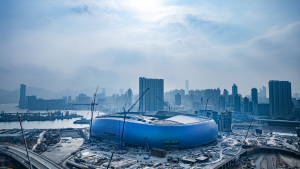Time is ripe for the construction industry to adopt ground-breaking innovative technologies such as BIM, geospatial, and Digital Twin. The decisionmakers need to mandate it across the project lifecycle.
Infrastructure is a core component of India’s vision to be a five trillion dollar economy as well as an illustration of its national ambition and growth trajectory. The sector is at an inflection point of creating economic prosperity, with drastically increased investments in recent years.
The country spent USD 1.1 trillion on infrastructure in the last decade and is scheduled to spend another USD 1.5 trillion by 2025. “India is at the cusp of investing a lot of money into infrastructure build-up, creating eleven industrial corridors, building new highways, dedicated freight corridors, high-speed rail, suburban metros, inland waterways, says Rajan Aiyer, Managing Director, Trimble Inc.
“All these major projects are revolutionizing Indian infrastructure to become world-class,” he adds. However, for the Indian construction sector to harness these opportunities efficiently, it must take past learnings into consideration to plan, design, and build better in the future. “To make India a five trillion dollar economy, we need to strengthen four sectors: water, power, transport, and communication. For the development of the infrastructure industry, we need digital transformation to take the lead. With digitalization, we can march towards perfection,” says Shri Nitin Gadkari, Union Road Transport and Highway Minister, in his inaugural session at the recently held GeoSmart Infrastructure Conference in New Delhi.
In the wake of the pandemic, India’s construction and infrastructure sector was paralyzed by long-standing inefficiencies and low productivity issues. But now the time is ripe for a complete digital overhaul.
As India embarks on massive infrastructural development, which will contribute to economic development, leading to a better quality of life and promote ease of living as per global standards, there is a need for the government (project owners) and industry to enable mechanisms and strategies to enable digitalization and leverage digital transformation tools and technologies.
“It is important to use technology in all infrastructure development projects, especially to improve planning, construction quality, and save unnecessary future expenditures due to short-sightedness and inappropriate detailed project report (DPR),” he adds.
For the government of India to achieve these goals and meet the aspirations laid out in the Infrastructure Vision 2025, there is an opportunity for all stakeholders to adopt advanced technology solutions such as BIM, geospatial and Digital Twin at all levels of construction project workflow. This would improve quality, cut costs, enhance safety, reduce risks and boost profit margins. And this has to be done now.
Sunil MK, Country Head – AEC, Autodesk India, echoes the urgency, “We need to adopt technology at a faster pace, and we do not have much time.”
New highways, dedicated freight corridors, high-speed rail, suburban metros, inland waterways, are revolutionizing Indian infrastructure to become world-class.
On the Path of Digital Transformation
Traditionally, the Indian construction and infrastructure sector has been slow in incorporating the latest technology across its workflows. But now, the fast pace of digitalization everywhere coupled with challenges associated with remote work, labor shortage, and inadequate coordination and collaboration has made tech adoption an imperative.
The use of geospatial and other digital technologies such as BIM, Digital Twin, and Artificial Intelligence, ensures on-time project delivery and on-site smooth functioning.
“Geospatial, BIM, and Digital Twin technologies helps us understand the complexities and visualize the options so that we can see the whole value proposition of the infrastructure even before start working on it.” says Sanjay Kumar, CEO and Founder, Geospatial World; Convenor – Non-Executive National BIM and Digital Twin Think Tank.
In agreement is General (Dr.) Vijay Kumar Singh PVSM, AVSM, VSM (Retd.), Minister of State, Ministry of Road Transport and Highways. General Singh sums up the need for digital transformation in the country, “As technology gets used more, challenges like time overrun and cost overrun can be addressed. We need to develop technology such that users find it useful and easy, thus we can get benefit in terms of quality, methodology, time and cost effective. Infrastructure industry and construction tech are changing by leaps and bounds. As land area is shrinking, we need technology and innovation to help us meet the requirements of infrastructure development as well as future of people.”
However, the construction and infrastructure world is highly complex and fraught with unique challenges. The majority of construction and infrastructure projects in India are highly fragmented, with different teams involved in the same project but working in silos, often with little or no synchronization or coordination.
The offices are very much disconnected from the work on the field, which causes delays, cost overruns, quality issues, and other inefficiencies in the project delivery process.
Kaushik Chakraborty, VP Asia-Pacific, Bentley Systems, says, “Life in the construction world is very tough. Often the entire process is disconnected, and here we use the word – dark data – meaning data which is disconnected across the lifecycle, so the stakeholders really don’t know what they have, creates huge challenges.”
BIM and Digital Twin – Definition and Need
BIM and Digital Twin are the pillars for achieving productivity and efficiency in the Indian construction and infrastructure sector. Building Information Modelling or BIM is a collaborative way of working, underpinned by digital technologies, which unlocks more efficient methods of designing, creating, and maintaining infrastructure assets. It embeds essential product and asset data in a 3-Dimensional (3D) computer model to effectively manage built asset data throughout the infrastructure project lifecycle – from concept through to operation.
Using BIM, architects, contractors, and structural engineers can work more collaboratively to access and update the design in a consistent and coordinated manner. BIM provides insights into the constructability of design, reduces errors, and improves the efficiency and effectiveness of the construction process. The Indian construction and infrastructure sector needs to transition from CAD to BIM for intelligent decision-making and optimal asset performance.
Further, BIM not only helps the stakeholders to complete the projects in less time with fewer resources but also helps them to develop a systemic understanding of the different dimensions of the technology – 4D (sequencing), 5D(cost estimation), and 6D (project lifecycle information and sustainability) to downstream benefits to common citizens who utilize infrastructure assets daily.
Digital Twin, on the other hand, is a virtual replica of a physical asset, process, or service. “Digital Twin is just BIM which is alive, always updated, and data-driven. CAD came from a 2D-document- based world, BIM is a model-based world, and Digital Twins are data-centric. So it’s all about data and information you can gather and insights you can derive. Of course, GIS, CAD, and BIM are the foundation for Digital Twins,” explains Kaushik.
Digital Twins is rapidly progressing and will play a significant role in the coming days, enabling asset-centric organizations to combine their engineering, operational, and information technologies into a portal or augmented/immersive experiences. The pairing of the digital and physical entities allows for easy data analysis, and simulations that can help ward off problems even before they occur and allow for future planning. Implementing Digital Twins across construction and infrastructure projects will help stakeholders derive better insights, improve product performance, and enhance operational and strategic decisions.
According to Sunil MK, most Indian infrastructure projects are not delivered on time, and the only way to timely deliver projects is through digitalization. He further added that if the government were to mandate BIM, or any collaboration and project management tool for infrastructure projects – with a planned spent of USD 1.5 trillion – a 20 percent productivity or 300 billion dollars in savings could be achieved.
“BIM takes all inputs and the construction data coming from the design world, from construction sites and fields, and also takes the output so that the information we get is up-todate”, adds Kaushik.

A Mandate for All
While everything about the technology sounds wonderful, India’s capability in implementing geospatial, BIM, and Digital Twin technologies across construction and infrastructure lifecycles are still at a nascent stage.
This maturity differs significantly across the project lifecycle. GW Consulting assessed the on-ground reality of technology implementation and found India’s maturity to stand between levels one and two of the maturity curve, i.e., between the amateur and mature stages.
“This gap gives an opportunity to the policymakers to see where the industry is moving, where the technology is moving, and how they can create policies that are pro-business, pro-technology that will enable the growth of this infrastructure in terms of quality, cost, time and complexities,” adds Rajan, affirming the need for a policy and technology mandate in construction and infrastructure projects.
Karthik Mani, BIM Strategy Manager, WSP, foresees policy as an important pillar in the digitalization process. “There is a need for cross-collaboration, knowledge transfer, and information exchange between all diversified specialists. To achieve this, I feel we need to develop some kind of policy mandate”
“The articulation to the government authorities has to be very transparent, illustrating the costvalue benefit and the entire futuristic roadmap. Suppose they can come up with a policy mandate, to begin with, technology mandate in infrastructure projects. In that case, I believe the integration of Digital Twin, GIS and BIM will definitely realize,” he adds.
National BIM and Digital Twin Strategy
A high-level think tank led by Mr. Kamal Kishore, Member Secretary, National Disaster Management Authority, and co-chairs Shri Amit Kumar Ghosh, Additional Secretary, Ministry of Road Transport and Highways, and Mr. Hitesh Vaidya, Director – National Institute of Urban Affairs, has called for the development of an integrated National BIM and Digital Twin policy for India to harness the potential of technology and digital transformation for the Indian construction and infrastructure sector.
The Non-Executive National BIM and Digital Twin Think launched ‘The National BIM and Digital Twin Strategy’ report in the presence of Shri Nitin Gadkari at the GeoSmart Infrastructure Conference in New Delhi. The report considers a ‘whole-sector’ approach to springboard the development of a National BIM and Digital Twin policy across the sub-sector infrastructure projects (transport infrastructure and urban development projects) to overcome the bottlenecks which the Indian construction and infrastructure sector currently face. It sets out an action-oriented strategic plan for government and decision-makers across India’s construction and infrastructure community to adopt BIM and Digital Twin.
While listing the definition, role, importance, and return on investment generated from BIM and Digital Twins in infrastructure projects, the report called for developing a National BIM and Digital Twin policy. The report suggests the policy be developed in collaboration with industry, academia, and government to embed and develop BIM and Digital Twins capabilities within different infrastructure projects.

“Policies at the Government level are very important. The National BIM and Digital Twin Strategy is a good step in that direction, and I hope we can all work together and contribute to the advancement of the Indian AEC sector as a whole”, says Viraj Voditel, Founder and Director, Techture.
Data has been a very sensitive topic and is often referred to as the new oil. While it means different things to different people, its role within a BIM and Digital Twin environment is critical.
Data is also key to creating BIM and Digital Twin outputs. That’s why the strategy calls for the policy to have appropriate provisions on integrity, granularity, governance, accuracy, and sharing of data.
BIM models can be distorted and polluted if the data lacks integrity; for BIM to advance to Digital Twin, data interoperability is vital. Therefore, the strategy document focussing on data-related considerations while drafting a BIM Execution Plan for a project or a National BIM and Digital Twin policy.
The strategy also calls for the government to define appropriate performance-linked incentives, procurement guidelines, and capability submission guidelines as part of the policy framework and in sub-sectoral strategies.
For BIM and Digital Twin to be adopted, the government should release procurement guidelines in structured, detailed, classified, named, and coded format.
It should include aspects related to the management of risks, intellectual property, insurance, standards, and interoperability to ensure the seriousness of technology implementation required.
To foster innovation, education, and skill development, the strategy asks for creating a National BIM and Digital Twin Education Taskforce to deliver a broad industry awareness program and develop technology-related vocational and academic courses. It calls for the Education Taskforce to collaborate with academia and research organizations to develop indigenous technology capabilities while empowering technology vendors to establish Centres of Excellence for building competencies and capabilities in the domain.
The document emphasizes that a well-executed BIM and Digital Twin technology can boost productivity in the Indian construction and infrastructure sector by at least 25-30 percent on average. “Creating a federated and dynamic 3D Building Information Model (BIM) aids in better multi-party communication and a unified understanding of infrastructure through the 3D model.
The digitalization of infrastructure, roads, utilities, and electrical assets improves quantity estimation and led to reduced timelines and increased cost efficiencies, by leaps and bounds,” adds Viraj.

Changing the Tide
For India to sustain the momentum of transformation and continue on a high growth path, the government has made significant investments to build national infrastructure assets. However, there is a need to fast-track projects so that risks can be reduced. Currently, 80 percent of Indian project owners and contractors believe that project risks are rapidly rising.
Timely execution of projects within estimated costs and desired quality continues to be a challenge. The harsh reality of the Indian infrastructure industry is that the value of core construction technologies – such as BIM and Digital Twin, is still highly under-projected and marketed, especially by owners and construction enterprises.
While the value of geospatial and BIM is quite well recognized in the planning and design phases, its true potential is yet to be harnessed in the construction and operational phase. This conundrum makes it necessary for project owners, technology providers, and the construction and infrastruc-ture ecosystem to collaborate, raise awareness and showcase the value proposition of BIM and Digital Twin technologies in the sub-continent.
With the advent of the cloud, BIM, and Digital Twin have assumed greater significance in steering the course of technology adoption across construction and infrastructure projects. Comprehensive BIM adoption and connected IoT applications provide accurate insights and enhance decision-making capabilities throughout the lifecycle of the built environment.
Real-time connectivity with online sensors has led to Digital Twins, enabling seamless monitoring and administration of the construction processes, facility management, and environmental monitoring. It also streamlines other processes in infrastructure lifecycle operations.
The use of BIM and Digital Twin across the lifecycle of infrastructure projects will, thus, play a seminal role in socio-economic transformation while furthering sustainable development.
Opportunity or Threat?
Technology is always perceived as a double-edged sword, particularly in the construction and infrastructure sector, which is renowned for being the least digitalized sector globally. However, times are changing, and winners will always be those who dare to take risks.
In this scenario, policy and strategy reforms in symphony with technology implementation and innovation will make a significant impact on the future of the construction and infrastructure sector in the country.








